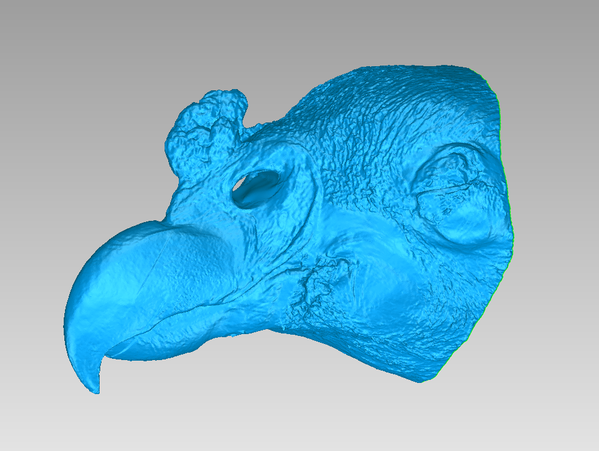Animals/Science
Comments
-
Where the hell have all the Sparrows gone? is there a connection in the efforts to protect birds of prey? (Including I presume Sparrowhawks?).0
-
We are 3D scanning every single bird species' beak. That is a picture of the final output from our scanners. All the scanning basically means is that we can take many more factors into account when analysing the shape of their beaks. Instead of just length, width and depth measurements, we can take things such as curvature into account. It also removes the human error that comes from taking measurements using callipers. On our twitter feed we run a competition every week to see if anyone can guess the species of bird from the scan, and sometimes many clues!Stig said:Interesting article (I'm enjoying this fledgling series mouatakilla. I don't understand the scanning picture though (although it looks very pretty). What does that mean? And for cuteness, that chick video is fantastic.
We will start taking some UV photographs of plumage again soon, and then hopefully I can get some of those up. It should give us an impression of the sort of things the birds would see.
Currently we are working on our crowd sourcing website, which will allow anyone (if they are interested), to get involved in our research. I am just having a play with it at the moment to iron out any kinks. It has some pretty cool functions, so looking forward to showing it to people.1 -
I actually got interviewed for a PhD position a few years back to look into this. They didn't get funding unfortunately, but would have been really interesting to study. From what I remember reading it was more to do with the decline in insect numbers, due to insecticides, causing chick starvation. I think there was a number of other factors playing their part, potentially increasing predator numbers (but I doubt this would cause the level of decline that we have seen) and loss of nesting sites.Halix said:Where the hell have all the Sparrows gone? is there a connection in the efforts to protect birds of prey? (Including I presume Sparrowhawks?).
Just had a quick look and there is this article from the independent:. It is a bit outdated now, so may be more factors people have researched by now!0 -
Doing a few this week. This one is on the Keel-billed toucan. Enjoyed writing this one http://tinyurl.com/naudzu2. Got a link to an excellent video of them thermoregulating using their beaks,1
-
Interesting. I’m happy for you Moutua as from your writing on here I know you worked really bloody hard to get there. I'll have a proper read when work has died down later today.
I’m slowly working my way into animals and conservation. My lemur volunteering is still going well but I need broader experience, hopefully within a couple of years I’ll be employable at Howletts. I want it to be Howletts as it’s 100% there for the animals, not people (unlike say Wingham).
I have plugged this before but I also write for The Lemur Conservation Network. They’ve asked for blogs to be more personal than factual, and as I’m flying to Madagascar next week(!) I should have a lot to talk about.2 -
This looks really interesting, i'll give it a read once I have finished work. Glad to hear you are still volunteering and that you are on your way to Madagascar - words cannot describe how jealous I am! Working with animals is a hard nut to crack, especially zoo work, i'm sure with all your hard work you will get there soonRedPanda said:Interesting. I’m happy for you Moutua as from your writing on here I know you worked really bloody hard to get there. I'll have a proper read when work has died down later today.
I’m slowly working my way into animals and conservation. My lemur volunteering is still going well but I need broader experience, hopefully within a couple of years I’ll be employable at Howletts. I want it to be Howletts as it’s 100% there for the animals, not people (unlike say Wingham).
I have plugged this before but I also write for The Lemur Conservation Network. They’ve asked for blogs to be more personal than factual, and as I’m flying to Madagascar next week(!) I should have a lot to talk about.0 -
I have recently discovered this website: http://www.onezoom.org/, which is a great way to look at evolution. It is a tree of life and covers all tetrapods on the planet. You can see how far back different species split off, and there are some cool animations too. There are links to more information as well if you want to read up on certain species, or see pictures etc.0
-
Today's installment is the I'iwi, one of the Hawaiian honeycreepers. More exciting than darwin's finches when it comes to adaptive radiation and evolution IMHO.
 http://tinyurl.com/ntvobjl 1
http://tinyurl.com/ntvobjl 1 -
Interesting that the flowers evolved to fit the birds' beaks.0
-
Sponsored links:
-
Fascinating. It's hard not to get the impression that evolution is just an ongoing experiment with no objective apart from ensuring diversity to ensure a few branches don't become extinct.moutuakilla said:I have recently discovered this website: http://www.onezoom.org/, which is a great way to look at evolution. It is a tree of life and covers all tetrapods on the planet. You can see how far back different species split off, and there are some cool animations too. There are links to more information as well if you want to read up on certain species, or see pictures etc.
I am a nature lover and admire immensely the work of conservationists because it is so vital. I support several conservation organisations but I'm ashamed to say i turn off many programmes because I don't want to see what we are destroying, i find it so depressing.
My only wish is that the conservation needs of what is beneath the sea could be brought home to more people. You notice if birds and animals are not where you used to see them, and cuddly or majestic mammals readily find sympathy, but people don't get to see what havoc we have caused from industrial trawling and netting and how much we have destroyed in our oceans.
The Faroese are reviled for killing a relatively small number of non-endangererd whales infrequently but the likes of Paul Watson gets $millions in public support , but few care as much about the decimation we ourselves have allowed, to the stocks of cod and herring that used too abound our shores. Conserving the uninteresting and uninspiring life at the lower end of the food chain must prove much more difficult to get public support for, but is surely no less important for conservation.
As is clear from your comments about the Phd position, if the funding isn't there, the conservation doesn't happen, however important the conservationists think it is.
1 -
The Kingfisher on our lake has only gone and got himself a bird


 10
10 -
http://www.bbc.co.uk/news/science-environment-33325854 This is the research I was involved in when I was out in Australia. Nice to see it on the Beeb!
Latest blog, not the best one as very little info on them.2 -
Swallow-winged Puffbird
Got one coming out on the King vulture, vulturine guineafowl and the eastern spinebill over the next week. Our crowdsourcing website should be up and running soon if anyone fancies being involved in some zoological research.2 -

This is a scan of a King Vulture that we did a few weeks back. Amazing creature, would absolutely love to see one in the wild!2 -
Madagascar has been and gone for me. It is so relentlessly poor, I know you read about it and see photos etc, but being there it can really bludgeon you. Yes it is an amazing place, but sadly only in isolated areas. If its wildlife is to be saved then its people desperately need help as well.
This is my first write up, from Andasibe national park where there are indris: http://lemurconservationnetwork.org/a-day-in-andasibe/ My next one will be from Ranomafana where I see my big one, black and white ruffed lemurs. That reduced me to tears like only Carlisle in 2012 has!1 -
Did you see any Sifakas running?0
-
Down in Isalo National Park there's a campsite where lemurs congregate around lunchtime. Red-fronted brown lemurs are total mischief makers.
Anyway, there used to be six Verraux's sifakas there but now there's only one sadly. We saw him or her bound between trees a couple times although I didn't get it on film. They really are special animals.0 -
Very jealous! Won't be getting there any time soon, but hopefully one day!
Here's my latest article on the Helmet Vanga, one of Madagascar's finest. Did you see any whilst you were out there?0 -
Unless you’re really into lemurs there are better overall experiences than Madagascar, I preferred Indonesia.
Nice. I don’t think so, I’m clueless with birds. The only one I remember is the blue coua in the eastern forests as it has a distinctive, shrill cry and apparently hunts chameleons.0 -
Sponsored links:
-
One of my highlights of research in the Amazon was seeing one of these from a tree-boat and trying to get the birders scope to focus in as it swayed around. Stunningly white is what I remember.moutuakilla said:
This is a scan of a King Vulture that we did a few weeks back. Amazing creature, would absolutely love to see one in the wild!1 -
That's good news as I have done Indonesia. Well when I say done, I have scratched the surface, would still love to get out to Sulawesi and see crested macaques and do some diving there. That is a nice looking Cuckoo! I am disappointed that I wasn't really into birds when I went to indonesia as there are so many amazing ones out there - hornbills etc.RedPanda said:Unless you’re really into lemurs there are better overall experiences than Madagascar, I preferred Indonesia.
Nice. I don’t think so, I’m clueless with birds. The only one I remember is the blue coua in the eastern forests as it has a distinctive, shrill cry and apparently hunts chameleons.0 -
It's a lovely sunny day. If anyone's out in their back garden, it's the ideal opportunity to participate in this.
http://www.bigbutterflycount.org/about1 -
Be doing this next week, good shout!Stig said:It's a lovely sunny day. If anyone's out in their back garden, it's the ideal opportunity to participate in this.
http://www.bigbutterflycount.org/about0 -
I haven't seen a ladybird yet this year0
-
Did you see any flying? They look so odd!se9addick said:Saw some Flamingos in the wild last week whilst in Curaçao - incredible animals (photos don't do justice but this is the best I could do)
0 -
Seen quite a few down in Kent, most in ages, although that is probably as I have been down the allotment and at national trust properties a fair bit!PL54 said:I haven't seen a ladybird yet this year
0 -
Not sure if this is going to work, but this is a visual representation of what we are doing with the 3D scanning. Not great photoshopping but it is a scan of a red wattlebird merged onto a photo I took last year0







